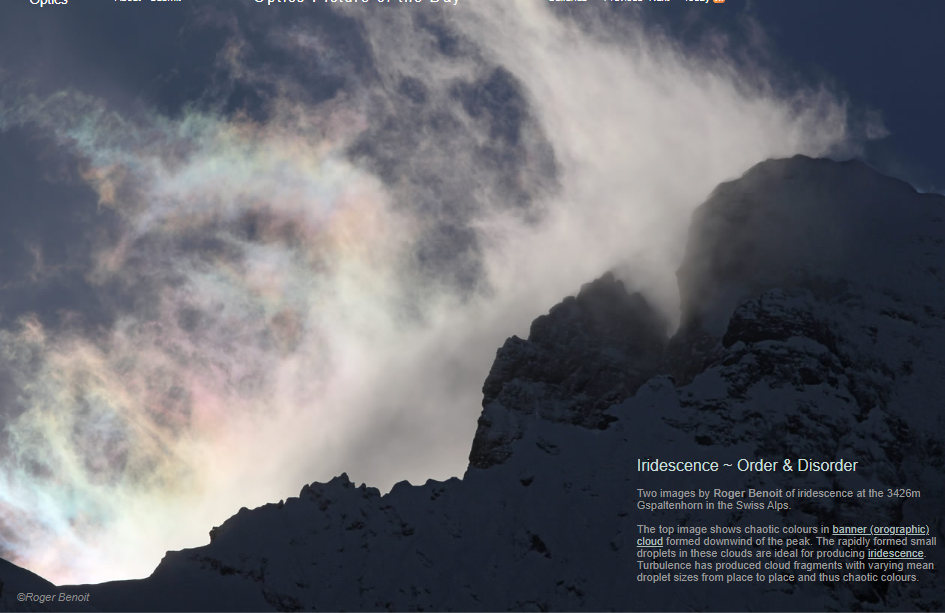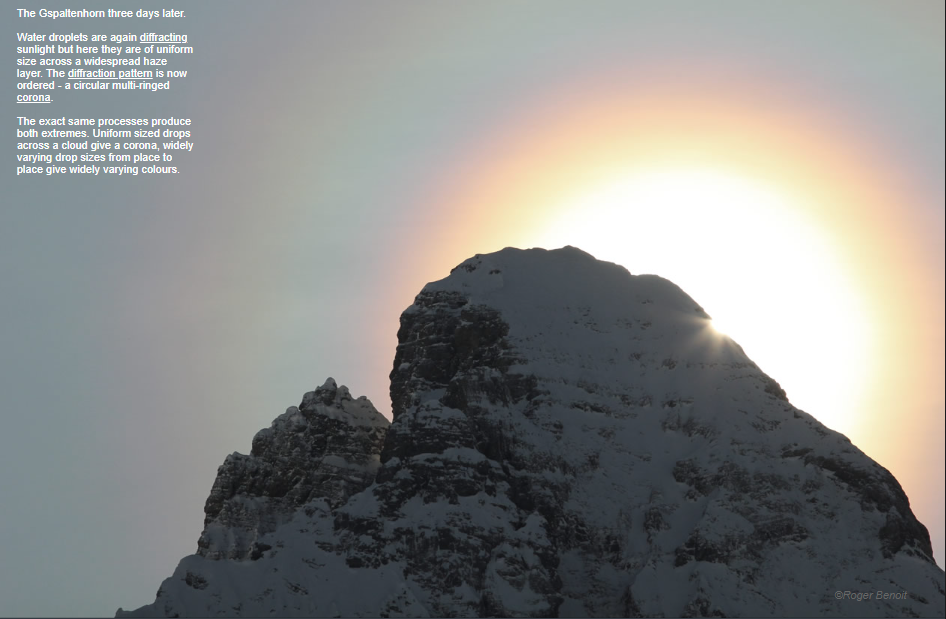OPOD - Iridescence, order and disorder
OPOD - Iridescence, Order and Disorder
Iridescence is a fascinating phenomenon that occurs in the atmosphere when light interacts with tiny water droplets or ice crystals. It creates beautiful, shimmering colors that can be seen in various atmospheric conditions. In this article, we will explore the concept of iridescence and how it relates to order and disorder in the atmosphere.
Chaotic Colors in Banner Clouds
One example of iridescence can be observed in the chaotic colors of banner clouds formed downwind of mountain peaks, such as the 3426m Gspaltenhorn in the Swiss Alps. These clouds are known as orographic clouds and are characterized by rapidly formed small droplets that are ideal for producing iridescence. The turbulence in the atmosphere leads to cloud fragments with varying mean droplet sizes from place to place, resulting in chaotic colors.
Uniformly Sized Drops and Circular Multi-Ringed Coronas
On the other hand, when water droplets are uniformly sized across a widespread haze layer, a different type of iridescence occurs. An example of this can be seen three days later at the Gspaltenhorn. In this case, the diffraction of sunlight by the uniform-sized droplets creates an ordered pattern known as a circular multi-ringed corona. This corona appears as concentric circles of colors around the sun or moon.
The Role of Droplet Size Variation
The key factor that determines whether iridescence appears as chaotic colors or an ordered corona is the variation in droplet sizes within a cloud or haze layer. When there is a wide range of droplet sizes from place to place, as in banner clouds, the resulting iridescence is characterized by disorder and ever-changing colors. On the other hand, when the droplet sizes are relatively uniform across a widespread area, the iridescence appears as an ordered pattern with concentric rings of colors.
The Science Behind Iridescence
The science behind iridescence lies in the interaction between light and the tiny water droplets or ice crystals in the atmosphere. When sunlight passes through these particles, it gets diffracted or scattered. This diffraction causes the different wavelengths of light to separate, resulting in the appearance of various colors. The exact colors observed depend on factors such as the size and shape of the particles, as well as the angle at which the light is observed.
The Beauty of Iridescence
Iridescence is a visual delight, captivating observers with its ever-changing colors and patterns. Whether it appears as chaotic colors in banner clouds or as an ordered corona in a haze layer, iridescence adds a touch of magic to the atmosphere. It reminds us of the intricate interactions between light and matter, and how nature can create mesmerizing displays for us to admire.
Real-Life Applications
While iridescence is primarily a natural phenomenon that occurs in the atmosphere, it has also found its way into human-made objects and materials. Inspired by the beauty of iridescent colors, designers and artists often incorporate iridescent finishes in products such as clothing, accessories, and even architectural elements. These artificial iridescent effects mimic the natural play of colors seen in iridescent clouds and offer a unique aesthetic appeal.
Capturing Iridescence in Photography
Photographers are often drawn to capturing the enchanting beauty of iridescence in their images. To photograph iridescent clouds or coronas, they need to consider factors such as the angle of the sun or moon, the position of the clouds or haze layer, and the overall lighting conditions. With careful planning and timing, photographers can capture stunning images that showcase the mesmerizing colors and patterns of iridescence.
Exploring the World of Atmospheric Optics
Iridescence is just one example of the many fascinating phenomena that occur in the realm of atmospheric optics. From rainbows and halos to mirages and glories, the study of atmospheric optics offers a glimpse into the wonders of light and its interactions with the atmosphere. Scientists and enthusiasts continue to explore these phenomena, deepening our understanding of the natural world and providing us with endless opportunities to marvel at its beauty.
Conclusion
Iridescence, with its order and disorder, showcases the complexity and diversity of atmospheric optics. From chaotic colors in banner clouds to ordered coronas in haze layers, iridescence adds a touch of magic to our skies. Understanding the science behind iridescence allows us to appreciate the beauty of this phenomenon and opens up avenues for artistic expression and scientific exploration. So, next time you gaze at the sky and witness a shimmering display of colors, take a moment to marvel at the intricate dance between light and nature.

Iridescence ~ Order & Disorder
Two images by Roger Benoit of iridescence at the 3426m Gspaltenhorn in the Swiss Alps.
The top image shows chaotic colours in banner (orographic) cloud formed downwind of the peak. The rapidly formed small droplets in these clouds are ideal for producing iridescence. Turbulence has produced cloud fragments with varying mean droplet sizes from place to place and thus chaotic colours.

The Gspaltenhorn three days later.
Water droplets are again diffracting sunlight but here they are of uniform size across a widespread haze layer. The diffraction pattern is now ordered - a circular multi-ringed corona.
The exact same processes produce both extremes. Uniform sized drops across a cloud give a corona, widely varying drop sizes from place to place give widely varying colours.
Note: this article has been automatically converted from the old site and may not appear as intended. You can find the original article here.
Reference Atmospheric Optics
If you use any of the definitions, information, or data presented on Atmospheric Optics, please copy the link or reference below to properly credit us as the reference source. Thank you!
-
<a href="https://atoptics.co.uk/blog/opod-iridescence-order-and-disorder/">OPOD - Iridescence, order and disorder</a>
-
"OPOD - Iridescence, order and disorder". Atmospheric Optics. Accessed on April 19, 2024. https://atoptics.co.uk/blog/opod-iridescence-order-and-disorder/.
-
"OPOD - Iridescence, order and disorder". Atmospheric Optics, https://atoptics.co.uk/blog/opod-iridescence-order-and-disorder/. Accessed 19 April, 2024
-
OPOD - Iridescence, order and disorder. Atmospheric Optics. Retrieved from https://atoptics.co.uk/blog/opod-iridescence-order-and-disorder/.